When you’re in the process of designing a product from scratch, it can be easy to assume that users will intuitively understand how you intended it to be used. But this usually isn’t the case. The same features that you find extremely easy to use can leave your users baffled and discouraged — unless you design your product to meet basic usability criteria. If your users are complaining that your product is confusing, inflexible, or error-prone, it’s time to take a step back and evaluate your design. And the best way to do this is by conducting a heuristic evaluation. A heuristic evaluation of your website or digital product can help you identify and resolve problems with it such as confusing flow, inconsistent design, jargon-laden copy, and frequent errors and mistakes. By helping you adhere to usability standards, a heuristic evaluation can help reduce user frustration and make your product easier to understand and use. Read 6 Key Steps to Performing a UX Audit
What is heuristic evaluation?
Heuristic evaluation is done on the basis of certain predefined criteria or heuristics. These can be understood as broad principles or rules of thumb rather than absolute guidelines. They provide a quick way to make design decisions around usability. Heuristic evaluation should not be confused with user testing, which is testing that is done by users. In contrast, heuristic evaluation should ideally be done by independent professional evaluators. During a heuristic evaluation, evaluators will check the site against the predefined list of usability criteria and report issues, usually assigning a numeric rating to each issue depending on its severity.Read A Beginner’s Guide to User Research
What are some commonly used usability heuristics?
There are many hundreds of criteria you could consider. But many people choose to use certain common checklists of criteria such as those defined by usability experts Jakob Nielsen and Rolf Molich in 1990. Nielsen’s 10 usability heuristics are commonly used for heuristic evaluation of websites and other digital products.

An alternative to Nielsen’s heuristics is Gerhardt-Powals' cognitive engineering principles. Considering your product’s unique context and purpose, you can opt to evaluate your product on the basis of a few or all the criteria from one or more such lists. Using these heuristics as a starting place, you can create review questions for your designs. You can also find existing lists of review questions and adjust them to suit your project.
Pros and cons of heuristic analysis

Heuristic evaluation cannot substitute for usability tests with real users. But it can help you identify some obvious issues and improve the quality of the product so that usability testing is more focused and productive. For this reason, it’s better to do a heuristic evaluation before usability testing. This method of testing also suits teams with varying sizes and budgets as it can be done by only 1-3 usability experts, which can be easier to set up than user testing. Finding users to test, share feedback and then validate the improvements can become complex and time-consuming. If you’re unable to hire usability experts, you can internally conduct a more informal usability markup. One disadvantage of heuristic evaluation is that if you haven’t chosen the right heuristics you may not spot all the usability issues in your product. Another disadvantage is that it can be easy for bias to slip in if you don’t select impartial evaluators. Still, on the whole, small teams may get more value from heuristic testing as compared to running an extensive user testing initiative. Read our Guide to Building Natural User Interfaces
How to conduct a heuristic evaluation
Heuristic evaluation can be done during the early stages of design. It can also be done as part of a UX audit at any stage of a product’s life cycle. These are the steps you would take to perform a heuristic evaluation:
Choose independent evaluators if possible.
Your site should ideally be tested by three usability experts separately. This ensures that issues that aren’t caught by one evaluator can be caught by another. Evaluators should be familiar with the industry, but they should not be end-users of the product. This ensures that they can give you the fresh perspective and feedback you might have missed by being too close to the product. If you’re not able to hire experts, you can opt to do the evaluation yourself or have it done by a small internal team.
Streamline the testing effort and brief evaluators.
You may wish to avoid the cost of testing your entire product and limit testing to specific areas. List any particular user stories or tasks that need to be tested. Define the parameters and objectives for testing, and also share user personas with evaluators so they can understand user motivations and frustrations. You may also want to share a severity rating scale with evaluators so that they can prioritize critical issues. Read How to Create the Best Color Palette for Your Product’s UI
Inspect and document feedback.
During the evaluation, it can help to have someone familiar with the product be present with the evaluators to document the findings as well as offer any clarifications. It’s recommended to do two walkthroughs. The first allows the experts to become familiar with the product and identify elements that need to be tested. On the second pass, they can do a deeper dive and record any usability issues. In case you are doing the evaluation yourself, you would try to put yourself in your users’ shoes and go through the entire user journey. As you accomplish the tasks your users might need to do, make note of any usability challenges you encounter. Take screenshots to record these and add your comments to each.
Compile findings and review.

Once the evaluators have completed the evaluation, you can bring all their findings together. This will allow you to identify overlaps, prioritize the issues found, and collate any suggestions and recommendations to improve the product. At the end of this process, you should have a prioritized list of usability issues that also references the heuristic principles that each issue fails to adhere to. This ensures that designers can then sort issues by type and severity and focus their attention on the most critical issues first. Read 25 Critical Questions to Ask When Starting a UX Project
To maximize value, adapt the assessment to your context
This process isn’t set in stone. Not all heuristics will make sense for your product and industry niche. Select the criteria and the processes that work for you and feel free to modify or leave the rest. Heuristic evaluation isn’t a perfect evaluation method that can help you catch all issues with your product, and it shouldn’t be the only one you use. However, it can get you to a strong baseline. From here, you can go on to build a great product with the help of other user research and audit methods as well as best practices. Read What are Mood Boards and How Are They Important in the UX Design World?
.avif)









.jpg)









